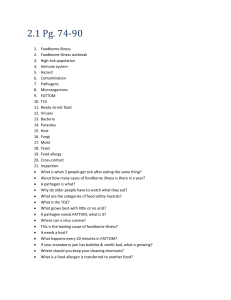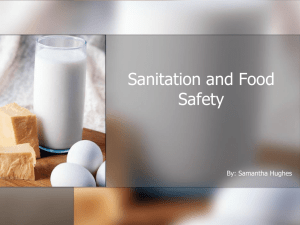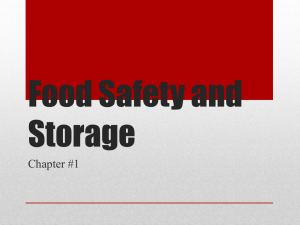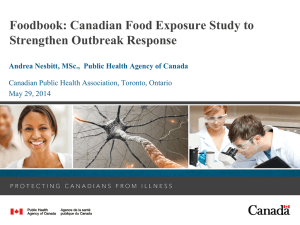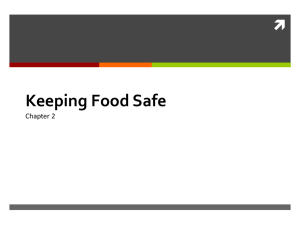Handouts 1-9 - F371 (Food Sanitation) (MSWord: 196KB/11 pages)
advertisement
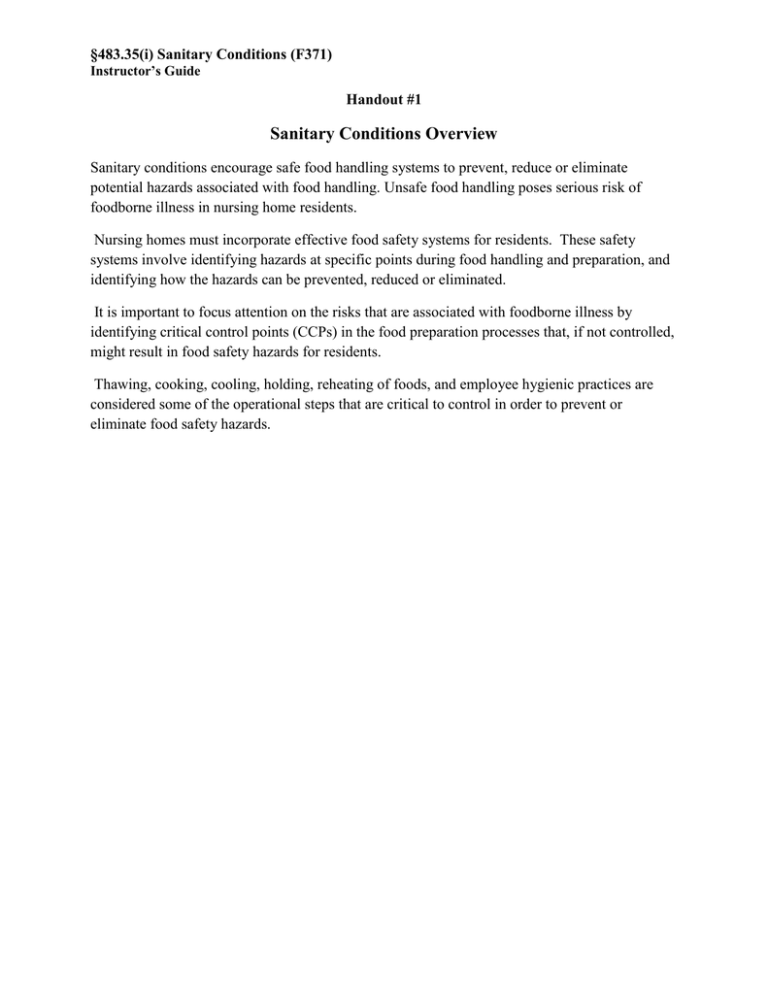
§483.35(i) Sanitary Conditions (F371) Instructor’s Guide Handout #1 Sanitary Conditions Overview Sanitary conditions encourage safe food handling systems to prevent, reduce or eliminate potential hazards associated with food handling. Unsafe food handling poses serious risk of foodborne illness in nursing home residents. Nursing homes must incorporate effective food safety systems for residents. These safety systems involve identifying hazards at specific points during food handling and preparation, and identifying how the hazards can be prevented, reduced or eliminated. It is important to focus attention on the risks that are associated with foodborne illness by identifying critical control points (CCPs) in the food preparation processes that, if not controlled, might result in food safety hazards for residents. Thawing, cooking, cooling, holding, reheating of foods, and employee hygienic practices are considered some of the operational steps that are critical to control in order to prevent or eliminate food safety hazards. §483.35(i) Sanitary Conditions (F371) Instructor’s Guide Handout #2 DEPARTMENT OF HEALTH & HUMAN SERVICES Centers for Medicare & Medicaid Services 7500 Security Boulevard, Mail Stop S2-12-25 Baltimore, Maryland 21244-1850 Center for Medicaid and State Operations/Survey and Certification Group Ref: S&C-08-09 DATE: January 11, 2008 TO: State Survey Agency Directors FROM: Director Survey and Certification Group SUBJECT: Nursing Homes: Surveying Facilities that Receive Food Prepared by Off-Site Kitchens Memorandum Summary • When a nursing home (facility) receives food services from an off-site location, the surveyor must assess whether the facility is compliant with 42 C.F.R. § 483.35(i) which states: “a facility must procure food from sources approved or considered satisfactory by Federal, State, or local authorities.” The purpose of this memorandum is to instruct surveyors on the appropriate action when surveying nursing homes that procure food prepared by sources external to the facility for the purpose of consumption by residents. The nursing home regulations at 42 C.F.R. Part 483 subpart B require nursing homes to ensure the safe procurement of food for the purpose of consumption by residents. The food sources must be approved or considered satisfactory by Federal, State, or local authorities. The regulation further states that the facility must store, prepare, distribute, and serve food under sanitary conditions. Determining Compliance It is not always necessary for surveyors to routinely survey off-site kitchens (any kitchen that is not operated by the “facility”) in cases where the food preparation entity is inspected by other Federal, State, or local authorities. Page 2 - State Survey Agency Directors The instructions below provide direction for surveyors when surveying nursing homes that receive food from external sources (off-site kitchens) for residents’ consumption. Surveyor(s) should determine if there are any: §483.35(i) Sanitary Conditions (F371) Instructor’s Guide Food safety and/or sanitary condition concerns related to when, where, and how the food received for residents’ consumption is prepared, packaged and delivered; Food safety and/or sanitary condition concerns related to when, where, and how the food is stored and served once it arrives at the facility; and On-site food safety and/or sanitary condition concerns such as but not limited to food-borne illness. If the surveyor(s) determine that a facility has food safety concerns warranting further evaluation, the surveyor(s) have the authority to inspect (survey) the food supply source (last point of preparation off-site kitchen). Even if the surveyor(s) determine that a facility has no food safety concerns, if the off-site kitchens are not inspected by other Federal, State or locally authorized food safety entities, or if the inspection results are not satisfactory (did not meet standards) then the surveyor(s) should cite the facility at 483.35(i)(1). If the off-site kitchen(s) are satisfactorily inspected (meeting standards) by other Federal, State or local authority and the surveyor(s) find no food-borne illness or other related issues at the primary survey location (the facility), the surveyor(s) may accept the results of the other Federal, State or locally approved inspection. The surveyor(s) must obtain documentation of the authorized inspection to satisfy compliance with the regulatory requirement related to the kitchen inspection. Even when the above criteria are met and the surveyor(s) accept the authoritative documentation of a kitchen inspection, once the food prepared off-site is brought to the facility, the surveyor(s) should proceed to investigate all on-site areas of the survey related to §483.35(i). Note: See section §483.35(i) and the State Operations Manual for further State Agency (SA) and the Centers for Medicare & Medicaid Services (CMS) Regional Office (RO) guidance when determining compliance with this regulation. The new guidance forthcoming for F tag 371(projected 2008) will include the above direction for surveying facilities serviced by off-site kitchens. For questions regarding this memorandum, please contact Debra Swinton-Spears at (410)-786-7506 or email at debra.swinton-spears@cms.hhs.gov. Effective Date: Immediately. Please ensure that all appropriate staff are fully informed within 30 days of the date of this memorandum, and disseminate the information to affected providers. Training: The information contained in this announcement should be shared with all nursing home surveyors and supervisors. /s/ Thomas E. Hamilton cc: Survey and Certification Regional Office Management §483.35(i) Sanitary Conditions (F371) Instructor’s Guide Handout #3 Strategies to Control Foodborne Illness Source of Contamination Primary Agents of Concern PHF/TCS Primary Control Strategies Fruits and vegetables, fresh E. coli O157:H7 Salmonella Norovirus Hepatitis A virus Shigella Cook to proper temperature Prevention of cross-contamination to ready-to-eat foods Ready-to-eat meat and poultry products Listeria monocytogenes Proper refrigeration during storage Pasteurized dairy products Listeria monocytogenes Proper refrigeration during storage Ice Norovirus Cleaning and sanitizing the internal components of the ice machine according to manufacturers’ guidelines Eggs, raw or unpasteurized Salmonella Cook to proper temperature Prevention of cross-contamination to ready-to-eat foods Poultry, raw Campylobacteria Salmonella Clostridium perfringens Cook to proper temperature Prevention of cross-contamination to ready-to-eat foods Meat, raw E. coli 0157:H7 Salmonella Campylobacter Clostridium perfringens Cook to proper temperature Prevention of cross-contamination to ready-to-eat foods Infectious food workers Norovirus Hepatitis A virus Shigella Salmonella Staphylococcus aureus Exclusion of infectious food workers Proper hand-washing procedures Avoid bare-hand contact with ready-to-eat foods §483.35(i) Sanitary Conditions (F371) Instructor’s Guide Handout #4 Safe Food Preparation Cross-contamination can occur when harmful substances or disease-causing microorganisms are transferred to food by hands, food contact surfaces, sponges, cloth towels, or utensils that are not cleaned after touching raw foods. Ways to reduce cross-contamination are to store raw meat (e.g., beef, pork, lamb, poultry, and seafood) separately and in drip-proof containers; sanitize towels/cloths, and test the sanitizing solution; wash and sanitize cutting boards; and clean and sanitize work surfaces and foodcontact equipment. Thawing frozen foods is often the first step in food preparation. Thawing food at room temperature is not acceptable because the food is within the danger zone for rapid bacterial proliferation. Recommended methods to safely thaw frozen foods include: thawing in the refrigerator, in a drip-proof container; completely submerging the item under cold water; microwaving the item and then cooking and serving immediately; and thawing as part of a continuous cooking process. Cooking is a critical control point in preventing foodborne illness that will either kill dangerous organisms or inactivate them sufficiently to prevent foodborne illness. Foods should reach the internal temperatures listed in the guidance. In particular, unpasteurized eggs when cooked to order in response to resident request and to be eaten promptly after cooking: 145 degrees F for 15 seconds, until the white is completely set and the yolk is congealed. Reheated cooked foods present a risk because they have passed through the danger zone multiple times during cooking, cooling, and reheating. The PHF/TCS food that is cooked and cooled must be reheated so that all parts of the food reach an internal temperature of 165 degrees F for at least 15 seconds before holding for hot service. Ready-to-eat foods that require heating before consumption are best taken directly from a sealed container. (Although proper reheating will kill most organisms of concern, some toxins, such as that produced by Staphylococcus aureus, cannot be inactivated by reheating food). NOTE: Using the steam table to reheat food is unacceptable since it does not bring the food to the proper temperature within acceptable timeframes. Fresh, frozen, or canned fruits and vegetables that are cooked do not require the same level of microorganism destruction as raw animal foods. §483.35(i) Sanitary Conditions (F371) Instructor’s Guide Handout #5 Selected Cooking, Reheating, and Cooling Temperatures For Foodborne Illness Prevention Process Food Item Final Cooking Temperatures Poultry and Stuffed Foods 165 degrees F Ground Meat 155 degrees F Fish and Other Meats 145 degrees F Unpasteurized Eggs 145 degrees F Internal Temperature 165 degrees F Intact Package 135 degrees F Reheating Foods Process Cooling Time Temperatures Temperatures Within 2 hours From 135 degrees F to 70 degrees F Within 4 hours Cooled to 41 degrees F Total time cooling not to exceed 6 hours Cooled from 135 degrees F to 41 degrees F §483.35(i) Sanitary Conditions (F371) Instructor’s Guide Handout #6 Prevention of Foodborne Illness Another major factor in causing foodborne illness is improper cooling. Taking too long to chill PHF/TCS foods has been consistently identified as one factor contributing to foodborne illness. Cooled food items can be re-contaminated by unsanitary handling practices or cross-contaminated from other food products, utensils, and equipment. Large or dense food items, such as roasts, turkeys, soups, stews, legumes, and chili, may require interventions in order to be chilled safely within an allowed time period. These foods take a long time to cool because of their volume and density. Residents who require a modified consistency diet may be at risk for developing foodborne illness because of the increased number of food handling steps required when preparing pureed and other modified consistency foods. When hot pureed, ground, or diced food drops into the danger zone (below 135 degrees F), the mechanically altered food must be reheated to 165 degrees F for at least 15 seconds. Pooled eggs are raw eggs that have been cracked and combined together. Salmonella infections associated with unpasteurized eggs can be prevented by using pasteurized shell eggs or egg products in foods that require pooling of eggs or foods that will not be thoroughly cooked. The U.S. Department of Agriculture, Food Safety and Inspection Service, Salmonella Enteritidis (SE) Risk Assessment states “A partial list of persons with increased susceptibility to infectious agents includes persons with chronic diseases, and nursing home residents. The elderly are particularly susceptible to infectious agents such as SE for a number of reasons. The disproportionate impact of severe complications and death from Salmonellosis in the elderly is illustrated by epidemiologic evidence.” Waivers to allow undercooked unpasteurized eggs for resident preference are not acceptable. Pasteurized shell eggs are available and allow for safe consumption of undercooked eggs. NOTE: Raw eggs with damaged shells are also unsafe because of the potential for contamination. §483.35(i) Sanitary Conditions (F371) Instructor’s Guide Handout #7 Food Service and Distribution Nursing home facilities use different systems to serve and distribute food items to residents. Some of these include tray lines, portable steam tables transported to a unit or dining area, open shelved food transport carts with covered trays, or enclosed carts that have hot and cold compartments. Some systems incorporate a heating element (pellet) under each plate of hot food. The tray line may include, but is not limited to the steam table where hot prepared foods are held and served, and the chilled area where cold foods are held and served. Dining locations include any area where one or more residents eat their meals. Snacks refer to those foods that are served between meals or at bedtime. Facility-sponsored special events, such as cookouts and picnics where food may not be prepared in the facility’s kitchen and is served outdoors or in other locations. If residents take prepared foods with them out of the facility, such as bag lunches, the foods must be handled and prepared for them with the same safe and sanitary approaches used during primary food preparation in the facility. Appropriate ice and water handling practices prevent contamination and the potential for waterborne illness. A potential cause of foodborne illness is improper storage of PHF/TCS food. The refrigerator must be in good repair and keep foods at or below 41 degrees F. The freezer must keep frozen foods frozen solid. §483.35(i) Sanitary Conditions (F371) Instructor’s Guide Handout #8 Equipment and Utensil Cleaning and Sanitation Dishwashing machines use either heat or chemical sanitization methods. The guidance references specifications according to the U.S. Department of Health and Human Services, Public Health Services, Food and Drug Administration Food Code (or according to manufacturer’s directions) for each method. A three-step process is used to manually wash, rinse, and sanitize dishware correctly. The first step is thorough washing using hot water and detergent after food particles have been scraped. The second is rinsing with hot water to remove all soap residues. The third step is sanitizing with either hot water or a chemical solution maintained at the correct concentration, based on periodic testing, and for the effective contact time according to manufacturer’s guidelines. When cleaning fixed equipment that cannot readily be immersed in water, the removable parts should be washed and sanitized while the non-removable parts are cleaned with detergent and hot water, rinsed, air-dried and sprayed with a sanitizing solution. §483.35(i) Sanitary Conditions (F371) Instructor’s Guide Handout #9 Potential Tags for Additional Investigation During the investigation of 42 CFR §483.35(i)(1)(2), the surveyor may have identified concerns related to these requirements. The surveyor should investigate these requirements before determining whether noncompliance may be present. The following are related outcome, process, and structure requirements that may be considered: 42 CFR 483.25(g)(2), F322, Nasogastric Tubes o Determine if residents have experienced nausea, vomiting, diarrhea, or other gastrointestinal symptoms as a result of the failure to store, handle, administer, or remove and discard tube feeding solutions in a safe and sanitary manner. 42 CFR 483.25(i), F325, Nutrition o Determine if multiple residents have experienced nausea, vomiting, diarrhea, or other gastrointestinal symptoms related to foodborne illness, which may impact their nutritional status. 42 CFR 483.30(a)(b), F353 Sufficient Staffing o Determine if the facility has sufficient staffing to meet the needs of the resident. 42 CFR 483.35(a)(1)(2), F361, Dietary Services - Staffing o Determine if the facility employs or consults with a qualified dietitian. If not employed full-time, determine if the director of food service receives scheduled consultation from the dietitian concerning storage, preparation, distribution and service of food under sanitary conditions. 42 CFR 483.35(b), F362, Standard Sufficient Staff o Determine if the facility employs sufficient support personnel competent to carry out the functions of the dietary service. 42 CFR 483.35(h) Paid Feeding Assistant o Determine if the Feeding Assistant has successfully completed a Stateapproved training course that meets Federal requirements and that the Feeding Assistant is utilizing proper techniques to prevent foodborne illness. 42 CFR 483.65(a), F441, Infection Control o Determine if the facility’s infection control program included investigation, control, and prevention of foodborne illness. 42 CFR 483.65(b)(3), F444, Hand washing Techniques o Determine if the facility has practices in place to prevent the spread of infection, including proper hand washing techniques. §483.35(i) Sanitary Conditions (F371) Instructor’s Guide 42 CFR 483.70(c)(2), F456, Maintain All Essential Equipment o Determine if the equipment in the kitchen, such as refrigerators, food carts, tray line equipment, freezers, dishwashers, ovens, stoves, and ranges etc. is maintained in safe operating condition and according to manufacturers’ specifications. 42 CFR 483.70(h), F465, Other Environmental Conditions o Determine if the kitchen physical environment, such as, floors, walls, ceilings, and vent hoods are safe, clean, and sanitary. 42 CFR 483.70(h)(4), F469, Effective Pest Control Program o Determine if the facility has maintained an effective pest control program so that it remains free of pests and rodents. Determine whether there is evidence of roaches, ants, flies, mice, etc. in food storage, preparation and service areas. 42 CFR 483.70(o) (2) (i) (ii), F520, Quality Assessment and Assurance o Determine whether the quality assessment and assurance committee seeks and reviews concerns related to foodborne illness, and food safety and sanitation to develop and implement appropriate actions to correct identified quality deficiencies when indicated.
